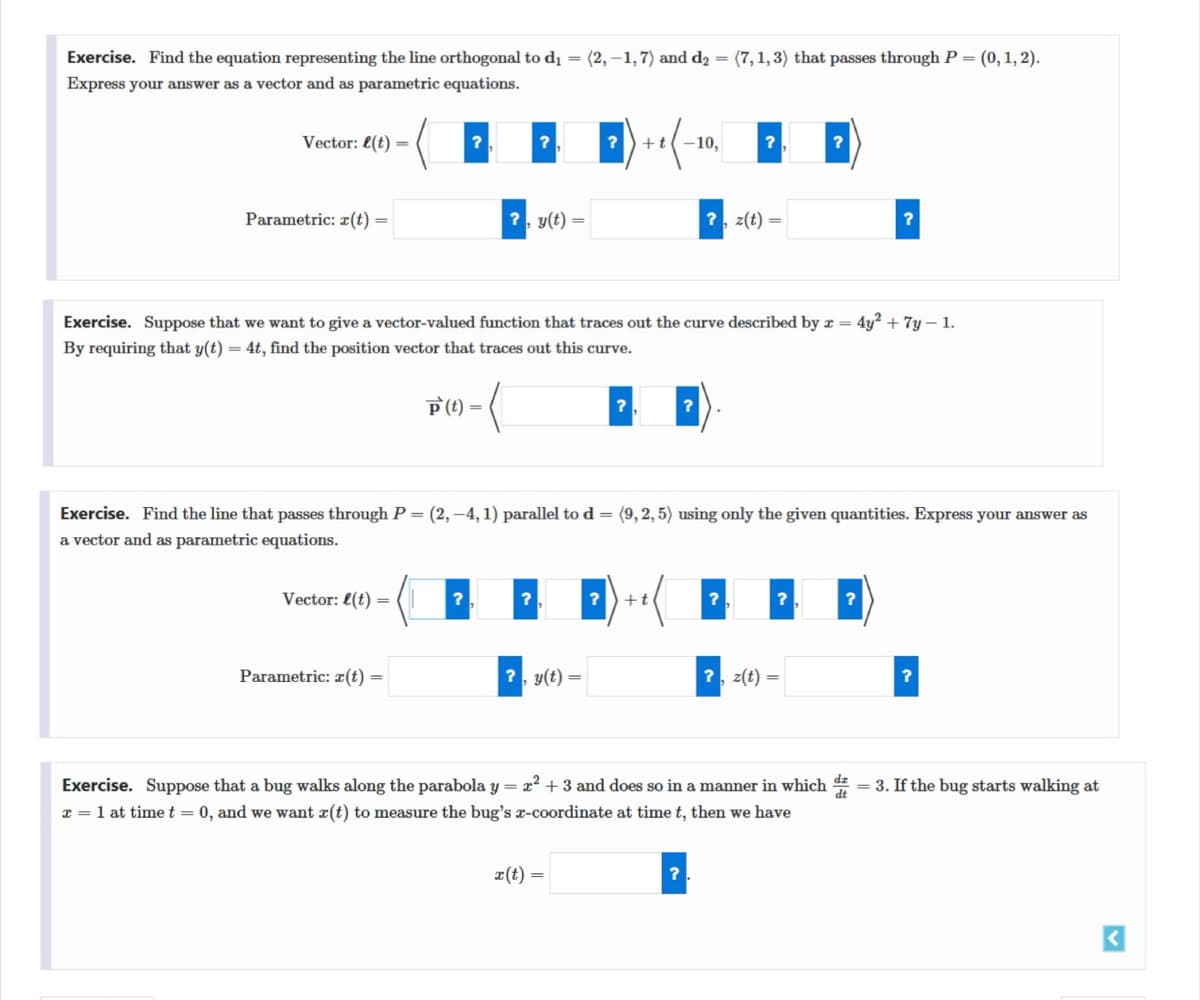Exercise. Find the equation representing the line orthogonal to dı = (2,–1,7) and d2 = (7,1,3) that passes through P= (0,1,2). Express your answer as a vector and as parametric equations. Vector: e(t) = ? +t(-10, Parametric: z(t) = ?, y(t) = ?, z(t) = Exercise. Suppose that we want to give a vector-valued function that traces out the curve described by z= 4y? + 7y - 1. By requiring that y(t) = 4t, find the position vector that traces out this curve. P (t) =
Exercise. Find the equation representing the line orthogonal to dı = (2,–1,7) and d2 = (7,1,3) that passes through P= (0,1,2). Express your answer as a vector and as parametric equations. Vector: e(t) = ? +t(-10, Parametric: z(t) = ?, y(t) = ?, z(t) = Exercise. Suppose that we want to give a vector-valued function that traces out the curve described by z= 4y? + 7y - 1. By requiring that y(t) = 4t, find the position vector that traces out this curve. P (t) =
Algebra & Trigonometry with Analytic Geometry
13th Edition
ISBN:9781133382119
Author:Swokowski
Publisher:Swokowski
Chapter3: Functions And Graphs
Section3.3: Lines
Problem 32E
Related questions
Question

Transcribed Image Text:Exercise. Find the equation representing the line orthogonal to dı = (2, –1,7) and d2 = (7,1, 3) that passes through P = (0,1, 2).
Express your answer as a vector and as parametric equations.
Vector: l(t) =
+t(-10,
Parametric: x(t) =
?, y(t) =
?, z(t) =
Exercise. Suppose that we want to give a vector-valued function that traces out the curve described by r = 4y² + 7y – 1.
By requiring that y(t) = 4t, find the position vector that traces out this curve.
P (t) =
Exercise. Find the line that passes through P = (2,-4, 1) parallel to d = (9, 2, 5) using only the given quantities. Express your answer as
a vector and as parametric equations.
Vector: l(t) =
+t
Parametric: z(t) =
?, y(t) =
?, z(t) =
Exercise. Suppose that a bug walks along the parabola y = x? + 3 and does so in a manner in which 4 = 3. If the bug starts walking at
x = 1 at timet = 0, and we want x(t) to measure the bug's x-coordinate at time t, then we have
dt
x(t) =
Expert Solution
This question has been solved!
Explore an expertly crafted, step-by-step solution for a thorough understanding of key concepts.
Step by step
Solved in 2 steps with 2 images

Recommended textbooks for you

Algebra & Trigonometry with Analytic Geometry
Algebra
ISBN:
9781133382119
Author:
Swokowski
Publisher:
Cengage

Linear Algebra: A Modern Introduction
Algebra
ISBN:
9781285463247
Author:
David Poole
Publisher:
Cengage Learning

Trigonometry (MindTap Course List)
Trigonometry
ISBN:
9781337278461
Author:
Ron Larson
Publisher:
Cengage Learning

Algebra & Trigonometry with Analytic Geometry
Algebra
ISBN:
9781133382119
Author:
Swokowski
Publisher:
Cengage

Linear Algebra: A Modern Introduction
Algebra
ISBN:
9781285463247
Author:
David Poole
Publisher:
Cengage Learning

Trigonometry (MindTap Course List)
Trigonometry
ISBN:
9781337278461
Author:
Ron Larson
Publisher:
Cengage Learning

Elementary Geometry For College Students, 7e
Geometry
ISBN:
9781337614085
Author:
Alexander, Daniel C.; Koeberlein, Geralyn M.
Publisher:
Cengage,